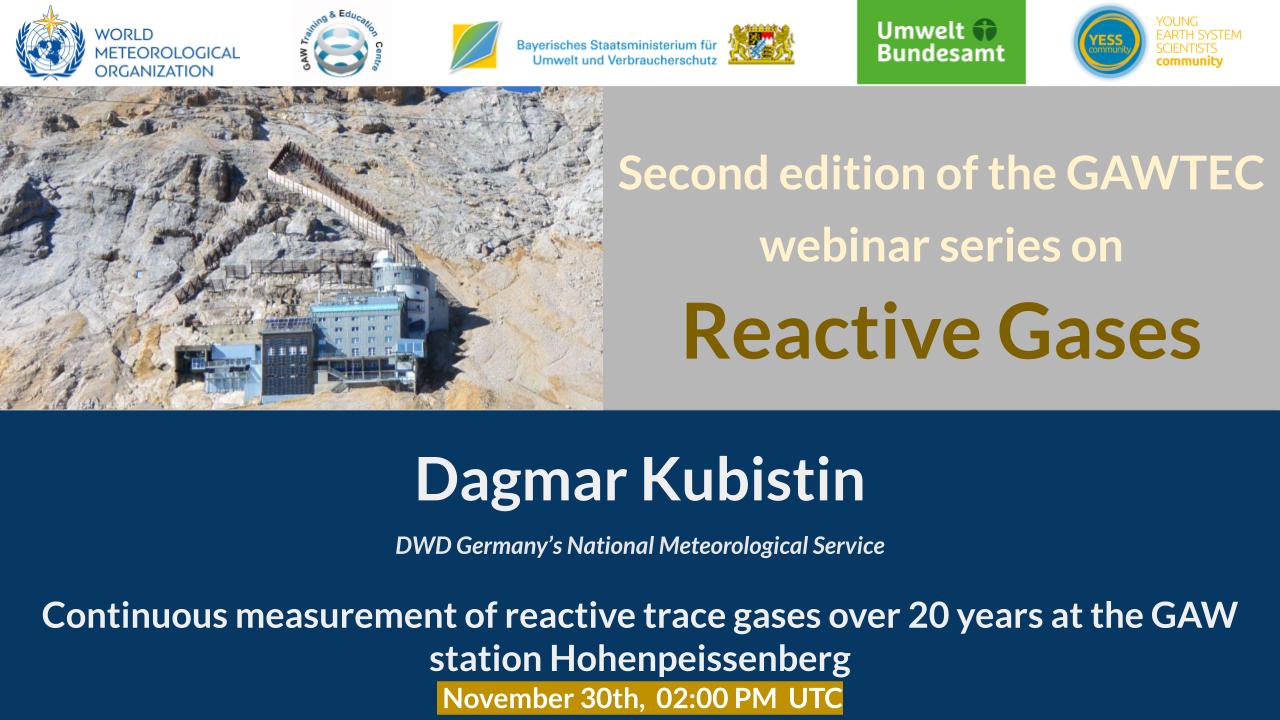2nd Webinar Series
YESS and the Global Atmosphere Watch (GAW) Programme of the World Meteorological Organization (WMO) are pleased to announce the second edition of the GAWTEC webinar series on reactive gases.
GAW focuses on building a single coordinated global understanding of atmospheric composition, its change, and helps to improve the understanding of interactions between the atmosphere, the oceans and the biosphere. It coordinates high-quality atmospheric composition observations across global to local scales to drive high-quality and impact science while co-producing a new generation of research enabled products and services.
The GAW Training and Education Centre (GAWTEC) is the only regular training facility for the atmospheric composition observations within WMO. Since the first GAWTEC training course in 2001, more than 419 participants from 80 different countries have visited and were trained at the Environmental Research Station Schneefernerhaus. Courses are offered twice per year. GAWTEC provides scientific guidance and instructions to GAW station personnel from worldwide global and regional stations.
The GAWTEC webinar series aims to provide scientific keynote presentations on atmospheric composition given by experts in their field and to provide a platform for exchange and questions for people interested in atmospheric composition, especially early career researchers. Its second edition focuses on reactive gases.
Webinar with Lucy Carpenter
Reactive Gases in the atmosphere and impacts on climate, human health and ecosystems
September 22nd, 2 pm UTC
Reactive gases in the atmosphere encompass a highly diverse group of chemicals with different properties and characteristics, including nitrogen oxides (NOx), volatile organic compounds (VOCs) and surface ozone (O3). These gases are chemically active and therefore present in only trace amounts in the atmosphere, with large variations in their concentration across space and time. The trace gases and their reaction products, which are formed through reaction with oxidants in the atmosphere, influence air pollution, climate and ecosystems. This talk gives an overview of the different sources and chemistry of reactive gases and discusses these important impacts.
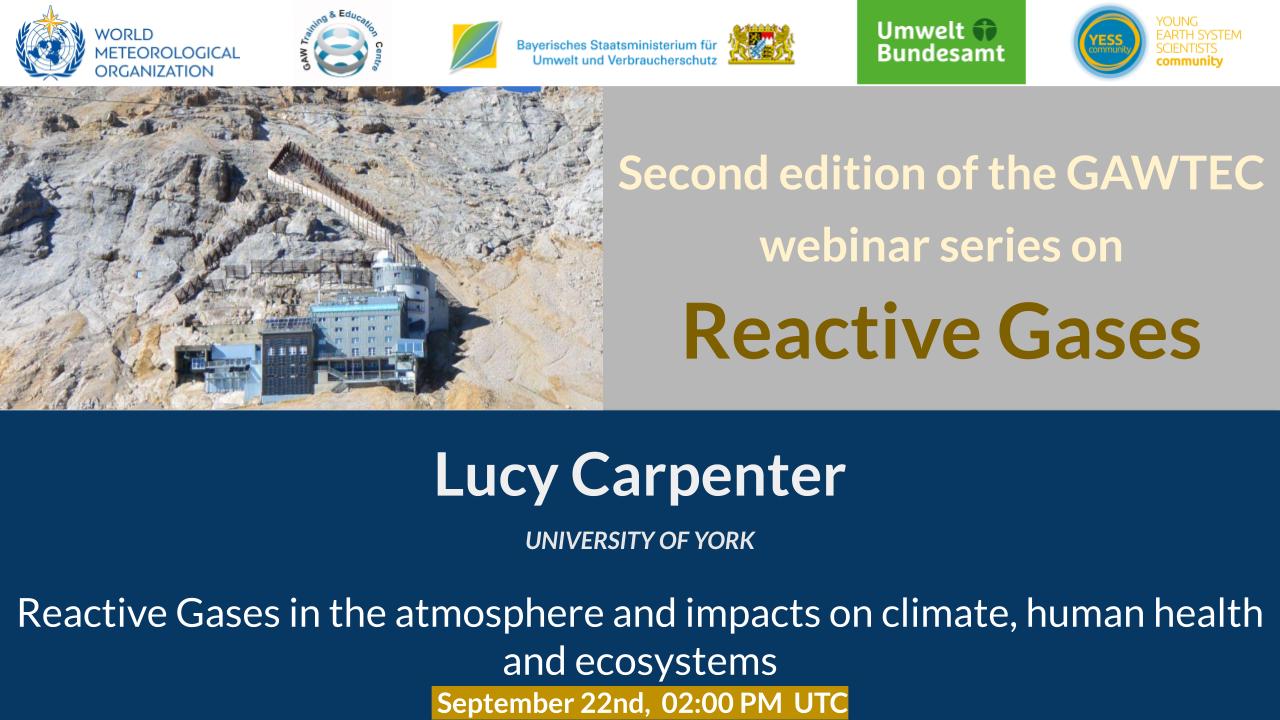
Webinar with Richard Olav Rud
How to submit data to EBAS
October 20th, 2 pm UTC
The EBAS atmospheric database, originally designed for the European Monitoring and Evaluation Programme (EMEP), archives today data on atmospheric composition from ground stations around the globe. GAW-WDCA and GAW-WDCRG are co-operating frameworks, and this presentation will provide information on how to submit data to EBAS and the benefits of storing the data in EBAS.
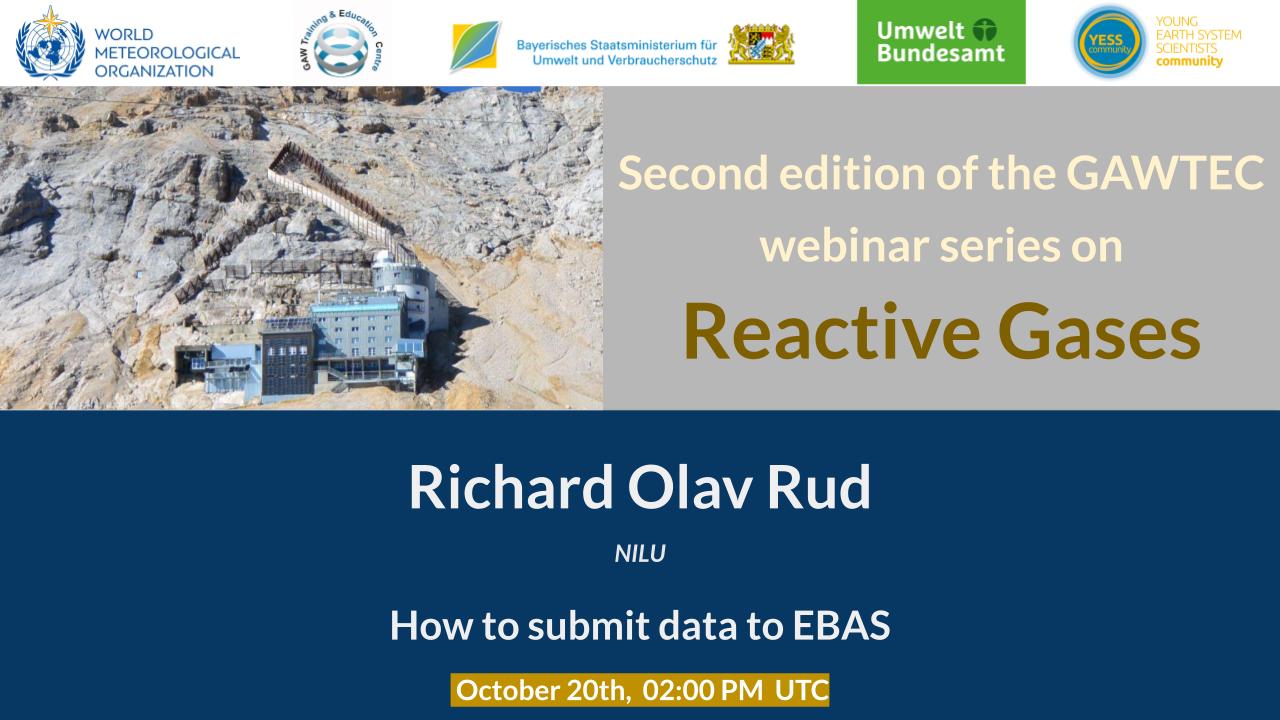
Webinar with Christoph Zellweger
Measurements of tropospheric ozone
October 27th, 2 pm UTC
Surface ozone is both a greenhouse gas and a secondary air pollutant which is harmful to human health and ecosystem productivity. It is not directly emitted but formed by chemical reactions of so-called ozone precursors (mainly nitrogen oxides, carbon monoxide, methane and non-methane volatile organic compounds) in the presence of sunlight. Since surface ozone is a regulated air pollutant, accurate and reproducible measurements are required.
This webinar gives an overview of ozone measurements in the Global Atmosphere Watch (GAW) programme and covers the following topics
- History of ozone measurement techniques
- Current measurement techniques for surface ozone
- Measurement setup
- Station settings and requirements
- Traceability, calibration and quality assurance of surface ozone measurements
- Overview of standards and guidance documents

Webinar with Martin Steinbacher
Carbon monoxide in the atmosphere – measurement techniques
November 4th, 2 pm UTC
Carbon monoxide (CO) is a central molecule in atmospheric composition monitoring and research. Mole fractions in the troposphere range from less than 100 ppb in remote areas to a few ppm in urban environments. Major sources are fossil fuel combustion, biomass burning and oxidation of methane and nonmethane hydrocarbons. Despite being a reactive gas with an atmospheric lifetime of a few days to months, CO is also considered as an indirect greenhouse gas as it interacts in the oxidative chain reactions and, consequently, also influences the lifetime of long-lived greenhouse gases such as methane. Thus, carbon monoxide plays an important role in atmospheric chemistry, the carbon cycle, and the Earth's radiative budget.
The Global Atmosphere Watch Programme (GAW) of the World Meteorological Organization lists CO as one of its recommended measurement variables. Several fundamentally different measurement techniques exist for CO observations. The lecture will give a comprehensive overview of the most common techniques and related quality assurance / quality control recommendations.
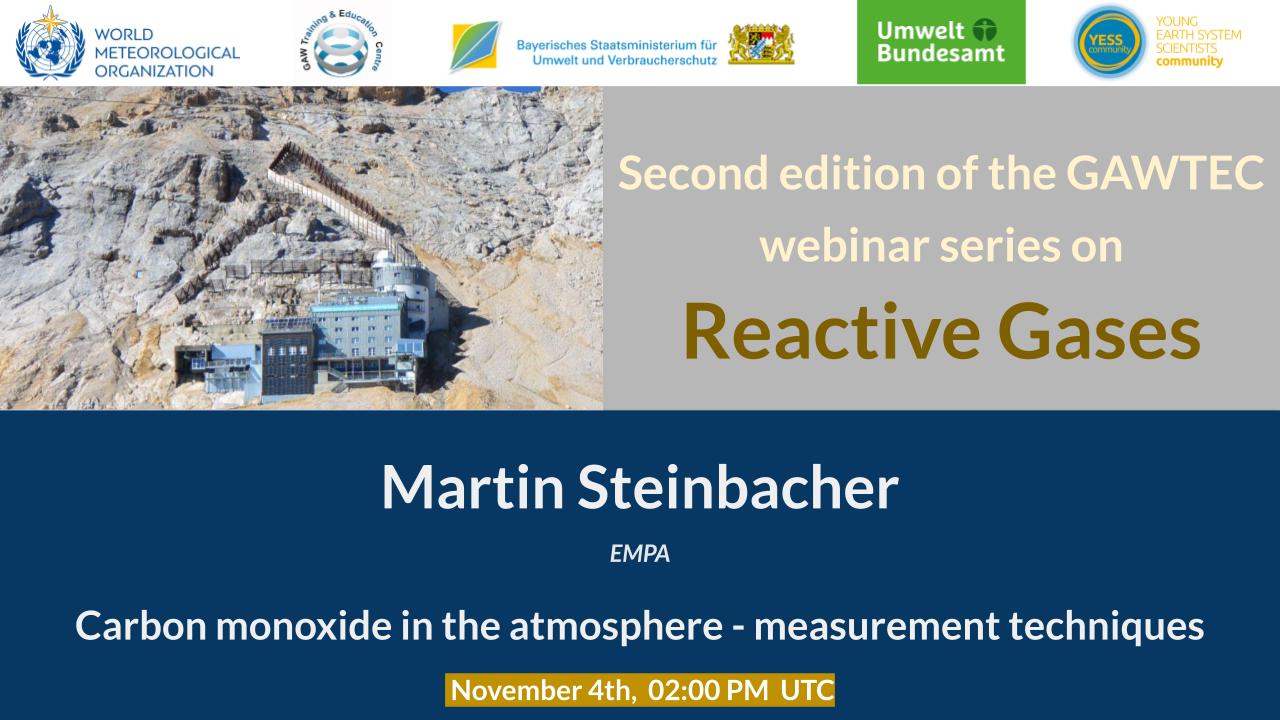
Webinar with Detlev Helmig
Methods for the Monitoring of Atmospheric Volatile Organic Compounds
November 10th, 2 pm UTC
Volatile Organic Compounds (VOCs) occur in the atmosphere at low to sub parts per billion mole fractions. This poses enormous challenges for their measurement and quantification. A variety of measurement approaches building on different principles have been developed that allow for the selective monitoring of VOCs at these low concentrations. This presentation will provide an overview of VOCs measurement approaches, their technical realization for monitoring methods, and examples of common applications.
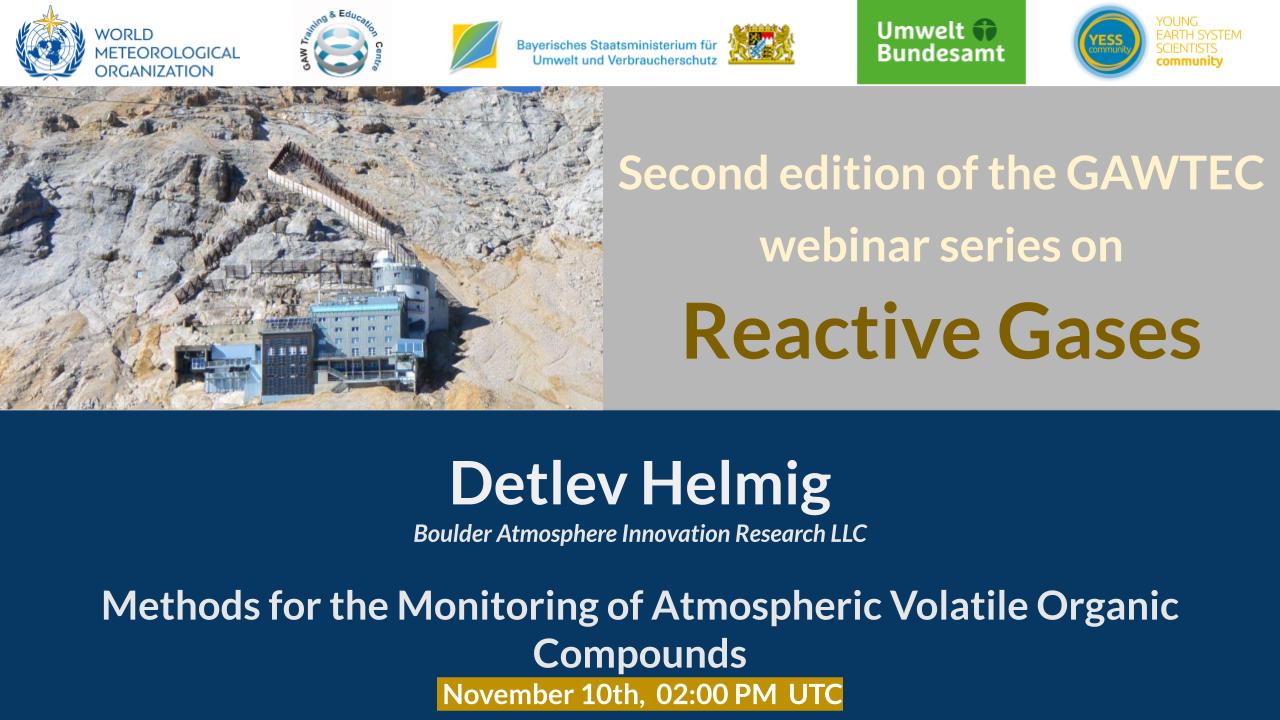
Webinar with Robert Wegener
Measurement of nitrogen oxides
November 24th, 2 pm UTC
Nitrogen oxides (NOx), the sum of nitrogen monoxide (NO) and nitrogen dioxide (NO2), play a central role in atmospheric chemistry. Nitrogen oxides form in the atmosphere during lightning strikes or during microbial processes in soils. The main part, however, is anthropogenic during combustion processes, with traffic being the main cause of nitrogen oxides. Although NO2 concentrations are decreasing, it is a still hazardous air pollutant in many parts of the world.
Consequently, there is a need to monitor nitrogen oxides. This is acknowledged in the World Meteorological Organization Global Atmospheric Watch Program.
In this lecture I will give an overview on the diurnal and seasonal cycles of nitrogen oxides an on the factors the govern the observed mixing ratios. In the second part measurements techniques of nitrogen oxides will be introduced.

Webinar with Dagmar Kubistin
Continuous measurements of reactive trace gases over 20 years at the GAW station Hohenpeissenberg
November 30th, 2 pm UTC
Anthropogenic emissions, climate change and mitigation strategies alter the composition of trace gases with impact on air quality and climate. Since 1995, the Hohenpeissenberg meteorological observatory operated by the German Meteorological Service (DWD) performs observations of atmospheric key species in Southern Germany within the Global Atmosphere Watch (GAW) program. The atmospheric composition, characteristic for central Europe, has been continuously monitored including reactive gases such as in-situ ozone, nitrogen oxides, carbon monoxide, anthropogenic and biogenic VOCs and total OH reactivity. This presentation will give an overview of the reactive trace gas measurement programme, their observations and interactions and the resulting change of the atmospheric composition at Hohenpeissenberg.
